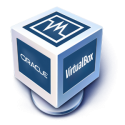Oct 262011

Chapter 5.For this chapter of the series we’ll take a look a the virtualization setup I used for testing. I went for VirtualBox and this is the setup I used to test the distributions I selected as candidates. To keep things fair I tested one distribution at a time with the same general parameters for each virtual machine.
The hardware settings were exactly the same for all tests. Of course I did select the correct distribution in the first step of machine creation. This changes the options in the next screens to optimal values for each distribution, but I made sure that all hardware parameters where the same for all tested instances.
Here is a list of the used settings during machine creation:
- The machine was allocated 2048 Mb (or 2 Gb) of memory
- A new virtual hard disk was created
- The VDI file type (native VirtualBox) was chosen
- Storage details where set to dynamically allocated
- The virtual disk was saved in a separate file for each test. The disk size was set to 50 Gb
After the machine was created the following parameters were altered:
- Under System -> Motherboard: the boot order was changed to CD -> HDD -> Network -> Floppy. The floppy was deselected. The chipset was changed to ICH9.
- Under System -> Processor: the number of processors was raised to 2.
- Under Display -> Video: the video memory was increased to 128 Mb (the maximum) and Enable 3D acceleration was selected. 2D acceleration is only for Windows OS, so it was left unselected.
- Under Network -> Adapter1: attached to was set to Bridged Adapter and eth1 was selected (a separate ethernet card for virtualization)
All other settings where left as they were. The only further change made was the insertion of a virtual media file for each distribution to boot from. This is the ISO CD or DVD image that was chosen to boot from.
Why VirtualBox?
- I am familiar with it.
- It can be run on my PC’s under both Linux and Windows.
- It is easy to take screenshots and document the whole process, including booting and setting up an operating system
- I can manipulate the graphical capabilities better than I would have been able to on my VMWare ESXi or Hyper-V servers (both have less capable graphics cards and abilities)
Switching to Linux series:
- Chapter 1 >> Switching To Linux: The Start
- Chapter 2 >> Switching To Linux: My Reasons
- Chapter 3 >> Switching To Linux: The Software List
- Chapter 4 >> Switching To Linux: The Distributions
- Chapter 5 >> This Article
- Chapter 6 >> Switching To Linux: Expectations and Criteria
- Chapter 7 >> Switching To Linux: Distribution Testing
- Chapter 8 >> Switching To Linux: Testing Distributions On Real Hardware
- Chapter 9 >> Switching To Linux: Ubuntu, The Surprising Winner
Related posts:
- Switching To Linux: Expectations and Criteria Chapter 6.Now that we have established how we are going...
- Switching To Linux: The Software List Chapter 3. As discussed in the first article in this...
- Switching To Linux: Ubuntu, The Surprising Winner Chapter 9. When I started the testing I would have never...
- Switching To Linux: Testing Distributions on Real Hardware Chapter 8.After selecting the 4 candidates and their testing order,...
- Switching To Linux: The Start Chapter 1. When I recently started thinking about buying a...















Sorry, the comment form is closed at this time.